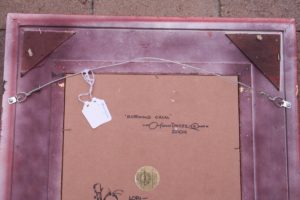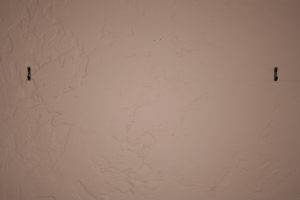 It’s a fact of life, first impressions matter. In the art world, galleries only have a few minutes to capture the attention of a prospective client. Most all successful galleries know this fact and use it to their advantage by professionally hanging and lighting their works of art.
It’s a fact of life, first impressions matter. In the art world, galleries only have a few minutes to capture the attention of a prospective client. Most all successful galleries know this fact and use it to their advantage by professionally hanging and lighting their works of art.
Don’t forget, a gallery’s job is to display our artwork in a pleasing and approachable manner in order to sell…and that is one of the reasons why they get paid the big bucks!
Hanging artwork and photographs baffles many, but there is a simple industry rule that you can learn to hang your art like a pro. Whether you are preparing for a show in a coffee shop, your studio or hanging art in your home, these simple guidelines will help you look professional.
Tips for hanging art:
In general, artwork should be hung so that the center point of the painting is at about eye level for the ‘average’ height person. Of course there are exceptions and breaking the rules in art can be allowed – but, only once you know the ‘rules’ of course. Make sure your artwork is ready to hang with appropriate wire for the weight of your artwork or with D-rings for heavier works. Then you will be ready to install your art…
Tools you will need:
-
Hammer
-
Pencil
-
Level
-
Measuring tape
-
Wall hooks
Important General Information:
-
Always use brackets or picture hooks – don’t just hammer nails into the wall.
-
Use hardware that will support your artwork.
-
Check the manufacturer’s recommendation on the package to make sure it will support more weight, never less than your artwork weighs.
-
Always check the hardware to make sure it is firmly secured with screws to the back of the frame/artwork
-
If the artwork is heavy, use two D-ring hangers – one on each side of painting to hang the art
-
When hanging a frame from a wire, use to hooks in the wall for added stability.
Installation Instructions:
-
Find and mark the center point from left to right, of the space in which you are displaying your art.
-
If using D-ring hangers without a wire, measure the art from top to bottom and mark the center of the piece under one of the hangers.
-
If using D-ring hangers measure from the center mark to the top of the picture hanger and add 60” to that measurement for a standard height. This will put the center of your art at eye level.
-
If using a wire, measure from the center mark to the top of the tightened wire and add 60” to that measurement for a standard height.
-
This will put the center of your art at eye level.
-
Measure and mark that distance up from the floor near your center mark on the wall. Align the marks with a level.
-
This will be your center height mark.
-
Measure the distance between the centers of the picture hangers on the back of the art. Divide that measurement in half.
-
You will use this measurement in the next step.
-
Using this measurement, hold that number on your tape to the center height mark on the wall and mark the distance between the hangers. For example: Let’s say your hangers are 20” apart, set the 10” mark in the center height mark. Mark the wall at the end of your tape measure and at the 20” mark.
-
Use the level to align these marks with the center height mark.
-
Position the bottom of the wall hooks on your marks and hammer in place.
-
If hanging from a wire, makes sure the wire on the back of the artwork is tight enough to hide the hanger when the artwork is hanging on the wall.
-
Lift the art onto the wall hooks. Use the level to check that the art is level.
Once you learn where the appealing ‘eye level’ is for your art, you can then hang your art without all the above measuring. But, the above guidelines will insure a professional look whether in your home or for an art show.
Hang in there! Lori 🙂
You might enjoy these other helpful articles:
Commissioned Art – Tips to Make it a Success!
How to Jumpstart Your Art Career
The Right Gallery – How to Find One
Should Artists Work with Galleries, Go Direct to Collectors or Both?
3 Tips for Artists to Promote themselves and Their Galleries
Connect with me on Facebook and Twitter











Thanks for this article! Having come out of art school and not learned anything like this, I of course turned to the internet when an exhibition required that I bring my work in with D rings attached – they didn’t explain anything and I was left feeling very confused. Hopefully I attach them right!
Hi Sarah…so glad this post helped you! I know how it feels to come out of art school with lots of questions…that is why i consider myself ‘self-taught’ because other than rendering, i’ve learned how to paint, etc. on my own! Come back and visit again 🙂
What about preparing canvas with gallery wrapped, edges painted, no frame?
I have a showing Tuesday and they hang by wire…should I just prep the frame of the canvas like a frame? and configure it to each possible scenario in ordered to look professional and prepared?
Hi Meri-
Great question and I hope I haven’t left you ‘hanging’ while waiting for my reply – lol! Yes, I would suggest following the same formula for hanging gallery wrapped edged works. Just screw the D-rings to the back of the canvas’ stretcher bar just like you would a framed piece of art.
Let me know how it goes. I’d love to see an example!
Thanks for the visit & comment-
Lori 🙂
Hi Lori,
Thanks for the tips. I am putting on a music and arts festival and we are building free-standing panels to hang the artwork on. Any tips on what color to make them? Gallery walls
always seem to be a dark neutral color. Any specific colors you’d recommend? I assume
a flat (non-gloss) would be best.
Thanks very much, Bill Watson
Hi Bill. Thanks for visiting and sharing your question…I hope I can help!
It sounds as though the art will be hanging outside, so I suggest staying away from too light a value because of glare. Also, I assume you will be showcasing a variety of works with different color palettes. I wouldn’t get too dark because the wall will look heavy and possibly dominate the art, especially if outdoors.
That said, middle shades of ‘taupe’ will probably work best. Taupe is nuetral and works well with most paintings. Choose a shade that is neither warm or cold…and try a few samples to see which will look best. This is the choice of the majority of my galleries. Some use ‘hunter green’ and that works well for landscapes, but not as well for other subjects…
Good luck – Lori 🙂
OK, here’s MY question. I’m fixing to do a show in a few weeks. Some of it’s going to be framed, some of it’s not going to be. How do you recommend displaying the unframed stuff? It’s mostly linen panel, but there’s also some stretched cotton. It’s outdoors, and I still haven’t come up with an answer. Thanks!
Ping me on Twitter (@Artists_Discuss) when you reply, so I can read your reply. Thanks!
Hi Martyn…
Good luck with your upcoming show – how exciting. Hmmm… I am assuming that you will be hanging the framed works. There are a few display options for your unframed paintings. At times I use small table top easels to display unframed paintings, this looks really nice. You can get theses little easels at Michaels or other craft/art supply stores or frame shops. Also, there are some hangers that might work…these hangers have a glue tab that should affix nicely to the back of the canvas/linen boards if they are not too heavy. Again, you can find these in most stores that sells art/frame supplies. Another idea is to use ‘plate hangers’ – these are used to hang decorative plates on walls. This might work – again found in a craft store or novelty shop. I hope this helps.
Thanks for the question and the visit! Lori 🙂
Like all good artist selling their art, I include the hanging wire and a ‘Picture Hanging Fact Sheet’ with every sale. It contains similar information to this. Think about it? Your work of art you would want it to be hung to reveal its true beauty on your buyer’s wall would you not?
Thanks Lori! I’m always helping my clients hang their artwork. I usually just wing it!
These tips will ensure that the next time I wing it, I’ll be winging it like an art hanging pro!
I know! I use to ‘wing-it’ too and still do sometimes…however, a gallery that I work with taught me this way of hanging and it really looks great!
Thanks for the feedback-
Lori 🙂
Hi Loria,
I just found your page which I found most informative. I recently volunteered to assist with the hanging of an exhibition and have a question. Can works which are framed, under glass or stretched canvas be hung together? There was much debate amongst the ‘hanging’ group where some felt the framed works had to be grouped and the same for the stretched canvases and the under glass works, which I felt restricted the flow of the exhibition. Any advice would be much appreciated. Regards Angela
Hello Angela,
There are no real ‘rules’, but generally speaking groups of the same type of framing look better hung together. I would suggest laying out the show on the floor below the wall before you start putting nails in the wall. That way you can mix things around and make decisions. If you have more than one wall, you might strive to hang the glass framed pieces together on another wall. I hope this helps! Let me know…
Lori 🙂
Hi Lori,
Thanks for the very usefull article, next month i am going to display my artwork, so it will more helpful for me can you please tell that how can i packed my painting after sell.
Thanks in advance.
Shweta
Hello Shweta, I actually have a short video about packing paintings. Here it is…http://www.youtube.com/watch?v=q_25fo8hpgo Hope it helps you!
Lori 🙂
Thanks for the link…its really helpfull…:)
You are so welcome!
Thank You for the Tips, soon i will be hanging 🙂
Hanging a beautiful new piece of art is the best feeling. Thanks!
Hi Lori!
I was wondering if you had any advice on hanging canvases up at a Market Stall? Currently I have some plastic lattice (The stuff you use in the garden to grow plants up) and hang it from the metal poles of my marquee. I then just put thumb tacks in the backs of the canvas and hang them up. The problem is that in the wind, they fall off!!! Not so good.
Do you have any suggestions?
Thanks!
I have used those lattice panels in the past. They are not the greatest. You are probably trying to be cost effective, but here is a link that has top quality walls to hang your art.http://www.propanels.com/ I hope this inspires you…
Hey Lori,
Awesome job with this and especially the art hanging system work-around. You just saved me what could have been $400! I always appreciate an “artists’-artist”: that person who openly shares tips with others so we don’t all have to reinvent the wheel.
Your Colleague,
Diane
Hello again Diane, if you have any tips to share please let me know. I am always happy to share a great guest post!
Hi from Australia
Thanks for this useful information.
Can you advise me how far from the top of the frame should the D hooks be placed – a quarter of the way down, a third, is there a recommended distance ? Sometimes the top of the frame leans out too far from the wall when I hang it. Also I have a gallery hanging system installed along one wall and this method of hanging seems to affect how the painting sits on the wall.
Cheers
Gara
I know I am late in replying…been a crazy few months for me. I would put the D rings about 1/3 of the way down from the top of the painting. I hope this helps.
Hi Lori,
Very informative articles! I have my first art exposition in a month and I was wondering how you suggest listing painting prices? The café owner suggested individual cards for each painting instead of a list but some of the paintings will be very high up and listing the cards lower would cause them to be amongst merchandise….any advice?
Thanks again!
Lucy
Many, many apologies for the belated reply!! I can hardly keep up with my blog and painting, etc. I hope you found the answer by now. But, it depends. I think it is best to add the prices to a live exhibition because then it helps vet the interested buyers. I hope this helps.
Professionals do not hang pictures on walls with wires and hooks. They use special rails fixed to the wall.
Yes that is true, especially for larger piece of art. These tips came directly from one of today’s top art galleries in America. Thanks!